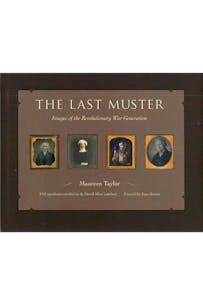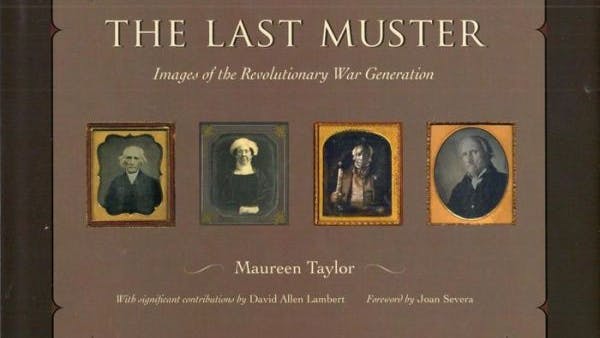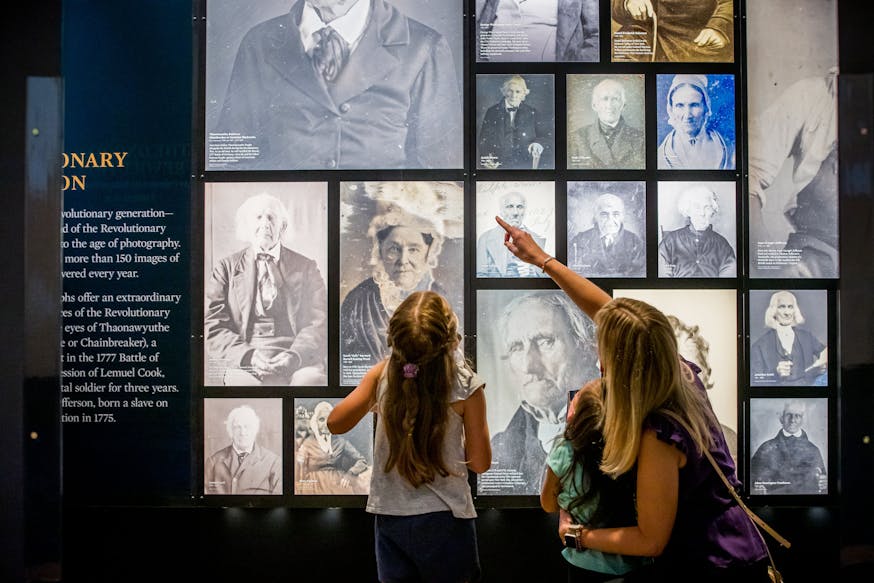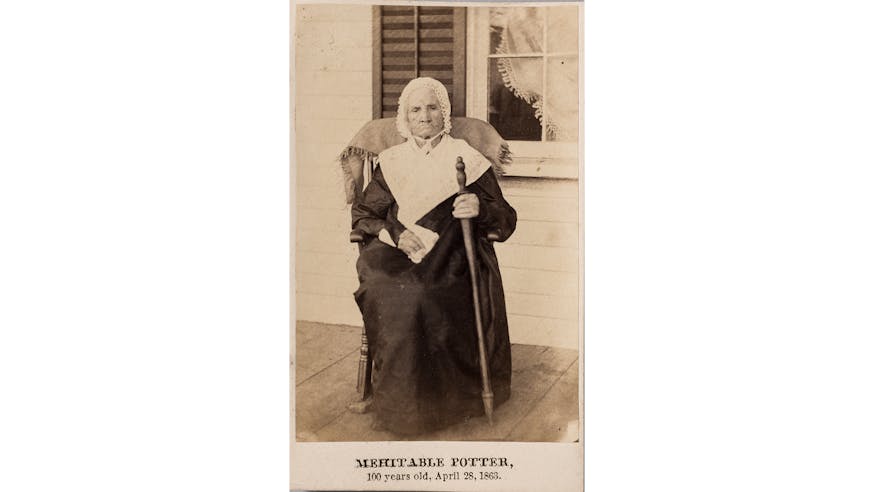Read the Revolution
The Last Muster
December 2, 2013
Purchase the book from the Museum Shop.
In Maureen Taylor’s The Last Muster, she compiles a rich collection of early 19th-century images of Revolutionary War veterans nearing the end of their lives. The faces of these men were preserved by a post-war invention—photography—which was popularized in the mid-1800s. In the book the photographs are paired with short vignettes that reveal the extraordinary and everyday actions each person made during the American Revolution. Today we feature three veterans from The Last Muster—Nathaniel Ames, Agrippa Hull, and Ezra Green—whose stories provide depth to our understanding of life during the Founding era.
Excerpt
Nathaniel Ames (1761-1863)
This venerable patriot and last living Revolutionary War veteran in Wisconsin spent his later years reminiscing to crowds at Fourth of July celebrations and in front of the fire with small groups of grandchildren about his years as a soldier. Born to David and Irene (Waldo) Ames in Scituate, Rhode Island, he was raised by his grandfather, Cornelius Waldo, and in turn assisted the elder in his old age.
When his grandfather refused to let him join the service at the age of seventeen in 1779, Ames ran away to become a militia guard for a month at Fort Griswold in Stonington, Connecticut... In June 1779 Ames enlisted in the regular army for a six-month stint at Stonington, Connecticut, serving with Colonel Betts’s Company at West Point. He reenlisted in December of that year to serve as substitute for another soldier, Joshua Barrons. Individuals were allowed to serve on behalf of another person. Discharged in 1780 at Springfield, New Jersey, having served out the remainder of Barron’s term of service, Ames then reenlisted for six months at Stonington, joining Captain Miles. He spent time at the Continental Army’s winter quarters at West Point and was discharged in January 1781...
For the remainder of the conflict, Ames served on a New London-built sixteen-gun privateer brig, the La Fayette. He sailed to Newport at the same time that a French fleet arrived in the harbor. He recalled waking to noise on the sidewalk outside his room caused by the wooden shoes worn by the French troops. Ames witness George Washington’s celebratory arrival in Newport. These events probably took place in 1779. In the summer of 1778, the Americans with French assistance tried to rout the British from Newport and failed. The city was a strategic location for the British, who wanted access to New York City, and the redcoats captured the town and held it until they abandoned it in 1779. The French, under the command of Rochambeau, then arrived in the city, and the townspeople welcomed George Washington...
On his 102nd birthday, Ames’s grandson with whom he was living gave him a party complete with band. Ames then entertained the guests with his wartime memories, including stories of the treason of Benedict Arnold and the execution of Major André. Not long before his death, when asked about the war, he recalled meeting Washington and General Baron von Steuben. He began to cry and asked attendees for their forgiveness for his emotional response: ‘You must excuse these expressions of an old man’s weakness, for I can never think of those good men without causing my heart to be stirred within me.’
Agrippa Hull (1759-1848)
’It is not the cover of the book, but what the book contains... many a good book has dark covers.’ Agrippa Hall, a Revolutionary War veteran, once remarked in a metaphor about race, not books. Hull, known as Grippy, was a celebrity in his native Stockbridge, Massachusetts, well known for his intelligence, witticisms, and quirkiness. He is one of the best-known African American figures of the American Revolution.
Born in 1759 in Northampton, Hull was brought to Stockbridge by Joab, a former servant of the religious revivalist Jonathan Edwards. Relatively little is known about his life before the American Revolution. When his mother married a second time, Hull supposedly didn’t like his stepfather and chose to enlist in the cause for American liberty, saying that the ‘war could not last too long for him.’
He joined the Colonial army as a free-born black in 1777 at the age of eighteen, for the duration. In his case, it was for more than six years of continuous military service. His first duties as a ‘servant,’ or orderly, to Gen. John Paterson of the Massachusetts Line lasted for two years. For the remaining four years two months of service he fulfilled the same role for Polish soldier Gen. Thaddeus Kosciuszko, accompanying both commanding officers to military actions throughout the colonies.
Hull first applied for a pension under the Act of 1818. A reverent patriot, Hull didn’t want to turn in hi original discharge papers in support of his pension application because it contained George Washington’s signature. In 1828, Charles Sedgwick, a local lawyer who was also Massachusetts Speaker of the House of Representatives, wrote letters of support asking for Hull’s pension without the signed documents, because ‘he had rather forego the pension than lose the discharge.’ Sedgwick’s petition was successful.
After the war, Hull purchased property in Stockbridge, where he became a caterer. In his spare time, Hull worked on behalf of the African American community. Together with Judge Theodore Sedgwick, father of the man who helped him obtain his pension, they sought to free Jane Darby, a slave who sought refuge in Stockbridge. Darby later became Hull’s first wife. “
Dr. Ezra Green (1746-1847)
In 1845, the ninety-nine-year-old Green held the distinction of being the oldest living Harvard University graduate. Born in 1746 he graduated with the class of 1765. At that time, the study of medicine was a profession often learned from a more experienced physician, and Green began studying with Dr. John Sprague of Newburyport, Massachusetts. By 1767, Green had his own practice in Dover, New Hampshire, and became a leading member of the community until the Battle of Bunker Hill in 1775. In 1776, Green became the surgeon of James Reed’s 2nd Continental Regiment in Gen. John Sullivan’s brigade.
According to his pension application of 1832, he traveled from Albany to Ticonderoga, and his company joined Benedict Arnold in Montreal during that officer’s fall back from Quebec. Green continued to care for troops in his unit until he was discharged in December 1776. At six foot three inches tall, Green was often mistaken by fellow soldiers for Gen. George Washington, both for his stature and for his demeanor.
After his discharge, Green remained at home for close to a year, until he received a commission in October 1777 to serve as ship’s surgeon on John Paul Jones’s eighteen-gun ‘ship-of-war,’ the Ranger. It was newly built on Langdon’s Island in Portsmouth harbor, New Hampshire, and Green joined it on its first voyage. There were 140 men on board in April 1778. Their first stop was France, followed by trips along the coast of England. Every day, from November 1, 1777, to September 27, 1778, Green kept a diary of his life on board the Ranger. At times he commented on the weather or detailed ships they chased. Noted are deaths of shipmates, names of deserters, and entertainments such as visits by ladies or shore-leave trips to the theater. ..
‘In the spring of 1779 he went on a cruise with Captain Simpson in the Ranger, in company with the warships, the Providence and the Queen of France. They encountered six brigs loaded with salt, under convoy of a brig of fourteen guns, and took them all in Portsmouth, New Hampshire. On another voyage they took seven of a Jamaica fleet full of rum, sugar, longwood, pimento, and other goods to Boston. In this case, ‘as they approached the harbor, the house-tops were crowded with people, alarmed at the sight of ten large ships coming up, supposing them to be a British fleet...’
Green held a number of different positions after the war-doctor, tavern keeper, retailer, local politician, church warden, justice of the peace, and postmaster. He was made the first postmaster of Dover in 1790... Green died in 1847, aged 101.
Maureen Taylor. The Last Muster (Kent: Kent State University Press, 2010), 20-21, 70-71, 81.
Read the Revolution is produced thanks to a grant from the National Endowment for the Humanities: exploring the human endeavor.
Any views, findings, conclusions, or recommendations expressed on this website do not necessarily reflect those of the National Endowment for the Humanities.
Read the Revolution is published biweekly by the Museum of the American Revolution to inspire learning about the history of the American Revolution and its ongoing relevance.
Sign Up
Get Read the Revolution features right to your inbox.
Tags
Learn More

The Last Muster

A New Nation
Core Exhibition
